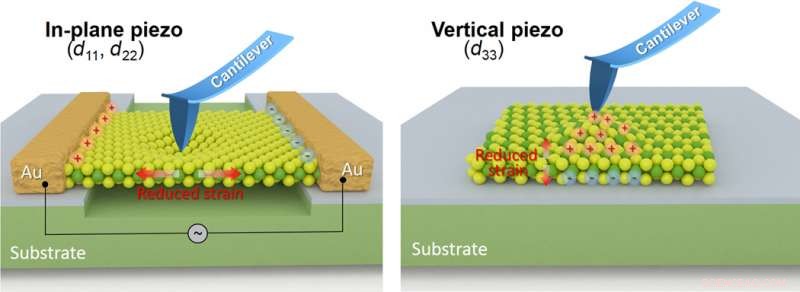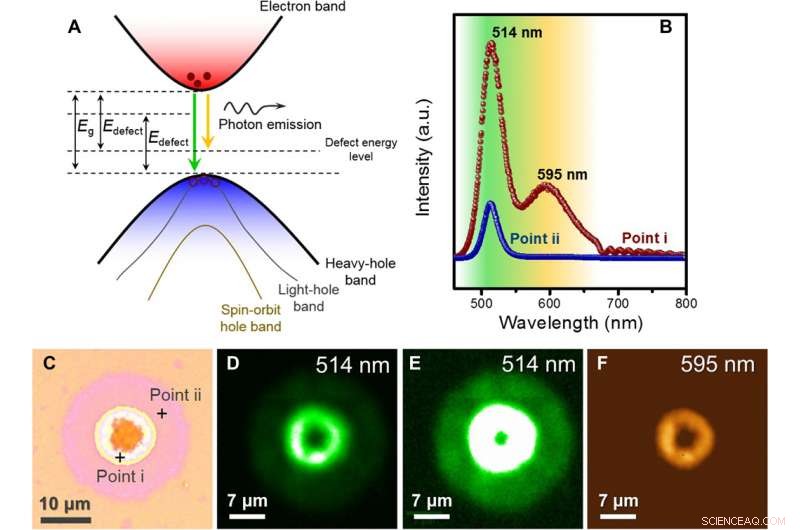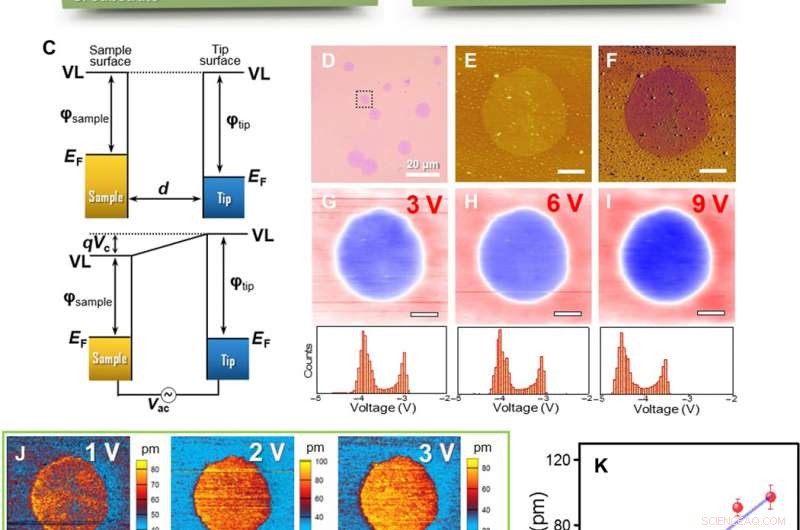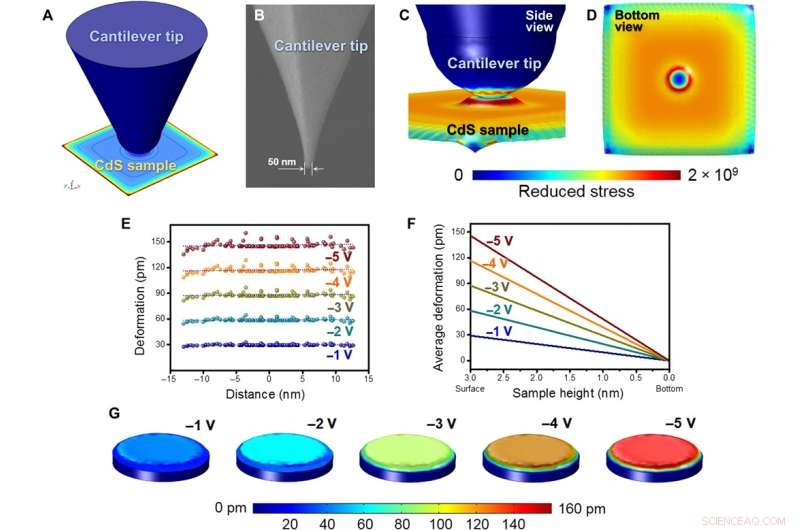
Fig. 1. Ilustração esquemática da caracterização local de piezoeletricidade em plano e piezoeletricidade vertical. Piezoeletricidade no plano (piezo) ( d 11 , d 22 ) de materiais ultrafinos é o comportamento do par eletromecânico planar, onde a tensão aplicada e o potencial piezoelétrico produzido estão localizados no plano do plano da rede exposta. Piezoeletricidade vertical ( d 33 ) foco na interação eletromecânica ocorrida no eixo vertical, que é perpendicular à superfície dos materiais. O atuador de deformação de alta precisão pode ser implementado usando o posicionamento preciso da superfície dos materiais por piezoeletricidade inversa vertical. Crédito:X. Wang, X. Ele, H. Zhu, L. Sun, W. Fu, X. Wang, L. C. Hoong, H. Wang, Q. Zeng, W. Zhao, J. Wei, Z. Jin, Z. Shen, J. Liu, T. Zhang, Z. Liu, Deformação subatômica impulsionada por piezoeletricidade vertical de filmes ultrafinos de CdS. Sci. Adv. 2, e1600209 (2016). Copyright © 2016 The Authors, alguns direitos reservados; licenciado exclusivo American Association for the Advancement of Science. Distribuído sob uma Licença Creative Commons Atribuição Não Comercial 4.0 (CC BY-NC). DOI:10.1126 / sciadv.1600209.
Piezoeletricidade ( também conhecido como o efeito piezoelétrico) ocorre dentro de certos materiais - cristais (notavelmente quartzo), algumas cerâmicas, osso, DNA, e uma série de proteínas - quando a aplicação de estresse mecânico ou vibração gera carga elétrica ou tensão de corrente alternada (CA), respectivamente. (Por outro lado, materiais piezoelétricos podem vibrar quando a tensão CA é aplicada a eles.) O efeito piezoelétrico tem uma gama significativa de utilizações, incluindo produção e detecção de som, geração de altas tensões e frequências eletrônicas, tecnologias de imagem de resolução atômica (por exemplo, tunelamento de varredura e microscopia de força atômica), e atuadores para posicionamento altamente preciso de objetos em nanoescala - o último sendo crucial para pesquisas fundamentais e aplicações industriais. Dito isso, o posicionamento da escala subatômica ainda apresenta vários desafios. Recentemente, Contudo, pesquisadores da Universidade Tecnológica de Nanyang, Cingapura, Academia Chinesa de Ciências, Suzhou, e a Duke University, Durham demonstrou piezoeletricidade vertical na escala atômica (três a cinco redes espaciais) usando filmes ultrafinos de sulfeto de cádmio (CdS). Os pesquisadores determinaram um coeficiente piezoelétrico vertical ( d 33 ) três vezes maior do que o CdS em massa usando no local microscopia de força Kelvin de varredura e microscopia de força piezoelétrica de rastreamento de ressonância ac simples e dupla, levando-os a concluir que suas descobertas têm uma série de papéis críticos no projeto de sensores de próxima geração e dispositivos microeletromecânicos.
O Prof. Zheng Liu discutiu o artigo que ele, Dr. Ting Zhang e seus colegas publicaram em Avanços da Ciência , descrevendo uma série de desafios que eles enfrentaram, começando com o uso de deposição química de vapor para sintetizar filmes finos de sulfeto de cádmio (CdS) de 2 ~ 3 nm. "A piezoeletricidade vertical, ou d 33 , é o parâmetro chave em materiais piezoelétricos para a fabricação de atuadores usados para posicionar objetos com extrema precisão - até a escala atômica em uma ampla gama de equipamentos de ponta, como microscopia de força atômica e microscopia de varredura por túnel, "Liu conta Phys.org . "Além disso, materiais piezoelétricos ultrafinos de alto desempenho são cruciais para a construção de dispositivos de ultra-alta resolução e flexíveis eletromecanicamente acoplados. "
Antes deste estudo, Liu aponta, apenas alguns estudos relataram a síntese de materiais piezoelétricos finos atômicos por um método químico úmido, exemplos dos quais incluem nanoplacas de seleneto de cádmio e CdS (CdSe). "É um desafio significativo produzir materiais piezoelétricos de alta qualidade e da espessura de um átomo, "acrescenta." Nesta pesquisa, o principal desafio na síntese de filmes de CdS piezoelétricos ultrafinos por meio de deposição química de vapor "(ou CVD)" está na seleção de precursores e em como otimizar os parâmetros de reação, como o aumento da temperatura e do tempo. "
Os cientistas foram então confrontados com a demonstração d 33 piezoeletricidade vertical em escala atômica usando filmes finos de sulfeto de cádmio ultrafinos. “Quando a espessura dos materiais atinge o nível da nanoescala, "Liu explica, "é muito difícil verificar o efeito piezoelétrico e determinar seus valores por causa do efeito de acoplamento do substrato - e as geometrias da superfície podem afetar as medições nos limites atômicos também." Por exemplo, ele ilustra, a rugosidade da superfície da amostra atinge dezenas de picômetros, que é a mesma escala com a resposta eletromecânica vertical para materiais.

Fig. 3. Caracterização espectroscópica do filme fino de CdS. (A) Energia ( E ) estrutura de banda na vizinhança do ponto Γ da zona de Brillouin, mostrando o processo de emissão de fótons. (B e C) Espectro PL de filme fino de CdS dos pontos i e ii marcados em (C) com sinais de mais, mostrando forte emissão de borda de banda (506 nm) de filme CdS ultrafino e emissão relacionada ao defeito (595 nm). (C) Imagem óptica de um filme fino de CdS com uma micropartícula arredondada no centro. a.u., unidades arbitrárias. (D e E) mapeamento de PL a uma emissão de 514 nm com uma barra de escala diferente, demonstrando alta uniformidade e homogeneidade de filmes finos de CdS na área externa. (F) Mapeamento de PL na emissão de 595 nm, indicando que a emissão relacionada ao defeito ocorre apenas na micropartícula de CdS mais espessa. Crédito:X. Wang, X. Ele, H. Zhu, L. Sun, W. Fu, X. Wang, L. C. Hoong, H. Wang, Q. Zeng, W. Zhao, J. Wei, Z. Jin, Z. Shen, J. Liu, T. Zhang, Z. Liu, Deformação subatômica impulsionada por piezoeletricidade vertical de filmes ultrafinos de CdS. Sci. Adv. 2, e1600209 (2016). Copyright © 2016 The Authors, alguns direitos reservados; licenciado exclusivo American Association for the Advancement of Science. Distribuído sob uma Licença Creative Commons Atribuição Não Comercial 4.0 (CC BY-NC). DOI:10.1126 / sciadv.1600209.
Por último - e uma reminiscência do desafio em demonstrar d 33 piezoeletricidade vertical em escala atômica usando filmes finos de CdS - os pesquisadores tiveram que determinar o coeficiente piezoelétrico vertical do filme CdS com no local microscopia de força Kelvin de varredura (SKFM) e microscopia de força piezoelétrica com rastreamento de ressonância AC simples e dupla (DART-PFM). "A qualidade do CdS piezoelétrico ultrafino é a chave para obter um coeficiente piezoelétrico vertical confiável." Anotações de Liu. "Algumas ferramentas de caracterização, como espectroscopias Raman e fotoluminescência, podem nos ajudar a identificar a amostra de CdS e confirmar sua alta qualidade. por causa das vibrações geométricas das amostras de CdS, a caracterização da microscopia de força atômica deve ser realizada com cuidado para garantir que nossas conclusões sejam sólidas. "Isso exigiu que os pesquisadores examinassem muitas amostras SKFM e DART-PFM para chegar a uma conclusão sólida sobre o comportamento piezoelétrico vertical em filmes ultrafinos de CdS.
Liu comenta que enfrentar esses desafios requer técnicas inovadoras. "Pela primeira vez, we successfully synthesized high-quality atomic thin CdS films using CVD, and we demonstrated vertical piezoelectricity of these films at the atomic scale of 3~5 space lattices" (a space, or crystal, lattice being a periodically repeating two- or three-dimensional array of points or particles) "and observed the vertical piezoelectric domains. More importantly, " Liu continues, "our work shows an enhanced vertical piezoelectricity in CdS ultrathin films at a level three times larger than the CdS bulk counterpart, as well as higher than most of traditional piezoelectric materials." These results imply non-trivial piezoelectric behavior at atomic limits for a certain class of materials – which has not yet been well explored – and inspires the search for two-dimensional free-standing layered piezoelectric materials that are only one atom thick.
Liu points out that their findings shed light on the design of next-generation sensors, actuators and microelectromechanical devices, in that piezoelectric materials are the most important component for such devices. Especificamente, he says that their findings provide the opportunity for next-generation sensors and microelectromechanical devices in three ways:

Fig. 4. Noncontact SKFM and standard contact PFM investigation for CdS thin film. (A and B) Schematic illustration of SKFM (A) and PFM (B) measurements. (C) Band diagram of tip and sample when they are electrically separated (top graph) and electrically contacted (bottom graph). d , distance; VL, vacuum levels; q , electronic charge; V c , contact potential difference. (D) Optical image of CdS thin films. (E and F) Topography (E) and phase (F) images observed by SKFM mode for the single CdS thin film marked in (D). (G to I) Corresponding potential mappings with tip voltages of 3, 6, and 9 V, respectivamente. Insets show histograms of the surface potential distributions. The CdS ultrathin film has a higher positive voltage (~0.9 V) than the substrate, demonstrating that a large amount of charges are accumulated at a CdS thin film after contact PFM scanning. (J) Amplitude images observed by contact PFM technology with tip voltages from 1 to 6 V, showing remarkable inverse piezoelectricity. (K) Average amplitude variations versus applied voltages calculated from (J). Error bars indicate 1 SD. Barras de escala, 2 μm (E to J). The linearly fitted line shows that the measured piezoelectric coefficient d efa is ~16.4 pm·V -1 , whereas the vertical piezoelectric coefficient d 33 is ~32.8 pm·V -1 . Credit:X. Wang, X. He, H. Zhu, L. Sun, W. Fu, X. Wang, L. C. Hoong, H. Wang, Q. Zeng, W. Zhao, J. Wei, Z. Jin, Z. Shen, J. Liu, T. Zhang, Z. Liu, Subatomic deformation driven by vertical piezoelectricity from CdS ultrathin films. Sci. Adv. 2, e1600209 (2016). Copyright © 2016 The Authors, some rights reserved; exclusive licensee American Association for the Advancement of Science. Distributed under a Creative Commons Attribution NonCommercial License 4.0 (CC BY-NC). DOI:10.1126/sciadv.1600209.
Liu illustrates these points by listing potential examples of such devices – for example, atomically thin piezoelectric devices – and their applications. "Por exemplo, using CdS ultrathin films, the most accurate probe or stage ever fabricated may be achievable, allowing researchers and engineers to manipulate atoms or position tips in atomic force, scanning electron and transmission electron microscopy. Em outras palavras, CdS ultrathin films will extend our capability to see and manipulate our world in an extreme way." Of more importance, ele adiciona, such ultrathin piezoelectric devices can be integrated into equipment like autocollimators and Michelson interferometers used in, por exemplo, cold atom studies, the verification of the gravitational inverse square law at short range, and even the detection of gravitational waves.
The study also reports the no local measurement of the ultrathin CdS film vertical piezoelectric coefficient d 33 , determining the film coefficient to be approximately three times larger than that of bulk CdS. "This value is pretty big for atomically thin materials, " Liu explains. "It means that we can get a large voltage change when small pressure or deformation is applied. This makes the material a great candidate constructing sensitive and ultrathin mechanical sensors."

Fig. 6. Simulation of vertical piezoelectricity and subatomic deformation actuator. (A) Three-dimensional image of potential drop on CdS film. (B) Scanning electron microscopy image of a conductive tip for PFM characterization. (C and D) Bottom and side views of stress distribution on CdS film. (E to G) Simulation for subatomic deformation actuator. Different potentials were applied to surface deformation curves (E), mappings (G), and vertical deformation (F) of CdS thin films. Credit:X. Wang, X. He, H. Zhu, L. Sun, W. Fu, X. Wang, L. C. Hoong, H. Wang, Q. Zeng, W. Zhao, J. Wei, Z. Jin, Z. Shen, J. Liu, T. Zhang, Z. Liu, Subatomic deformation driven by vertical piezoelectricity from CdS ultrathin films. Sci. Adv. 2, e1600209 (2016). Copyright © 2016 The Authors, some rights reserved; exclusive licensee American Association for the Advancement of Science. Distributed under a Creative Commons Attribution NonCommercial License 4.0 (CC BY-NC). DOI:10.1126/sciadv.1600209.
The researchers concluded that contact piezoresponse force microscopy (PFM) – which uses a conductive tip to apply a highly localized electric field that allows imaging and manipulation of piezoelectric ferroelectric materials – could significantly change the surface potential of a CdS ultrathin film by applying stress to its surface. "Tipicamente, applying mechanical stress to a piezoelectric material will generate electric charge that accumulates at the surface of the material, which is how we identify the piezoelectric materials, " Liu tells Phys.org . "We therefore believe that this results from piezoelectric polarizations giving rise to a large piezoelectric potential, in turn leading to a remarkable spatial separation of electrons and holes." In this case, electrons generated by the piezoelectric effect will be trapped into the silicon dioxide (SiO 2) dielectric layers, while the holes will be trapped inside the crystal boundary of the CdS films.
The scientists state that their work may pave a way to the synthesis of ultrathin lattice scale nanomaterials using CVD method, which is a low-cost method for producing high quality samples. Além disso, Liu notes, the materials provided by their study will enable the high-integrated and multi-functional devices by simply coating or transferring the film to the device. "For actuator applications, our work will promote next generation actuators with extreme resolution for their potential use in characterization tools such as ultra-high resolution microscopy; for atom manipulation and fabrication; or potentially for the detection of ultra-low deformation in, por exemplo, cold atom studies, verification of the gravitational inverse square law at short range, and even the detection of gravitational waves."
Seguindo em frente, Liu says, the scientists will determine the relationship between the vertical piezoelectric coefficient d 33 and the thickness of CdS at atomic scales. "Well also synthesize other piezoelectric, ferroelectric and layered piezoelectric/ferroelectric ultrathin materials, and explore their electromechanical properties." Based on this material and micro/nano-manufacture technology, the researchers hope to design and fabricate next-generation actuators for accurate positioning of minute objects, such as nanoparticles at subatomic scales, using their novel materials.
Além disso, the large vertical piezoelectric coefficient d 33 makes this material promising to construction of ultrathin and sensitive pressure sensors for detecting miniscule forces. If the low detection limit of sensor reaches to nanoscale levels, the device could monitor single biological cell migration.
"Our study will inspire material scientists to hunt for other non-trivial ultrathin or layered piezoelectric or ferroelectric materials, " Liu tells Phys.org . "Engineers can employ our CdS ultrathin films to design and fabricate novel microelectromechanical systems, " or MEMS, "and nanoelectromechanical systems, " or NEMS, "with high-integration and multi-functionalities, and may benefit when developing cutting-edge scientific instruments. Além disso, "ele conclui, "novel and flexible consumer electronic devices can be developed based on our study."
© 2016 Phys.org